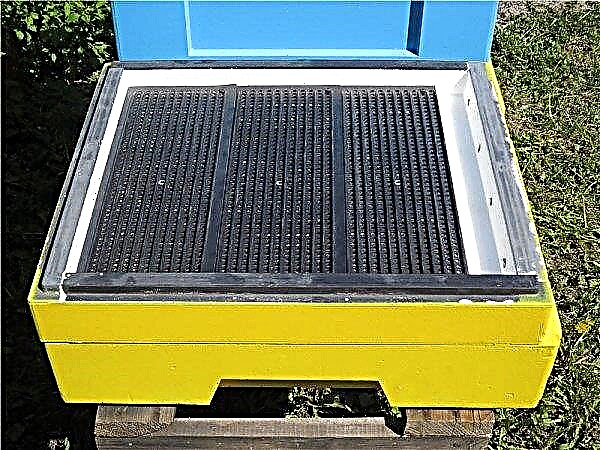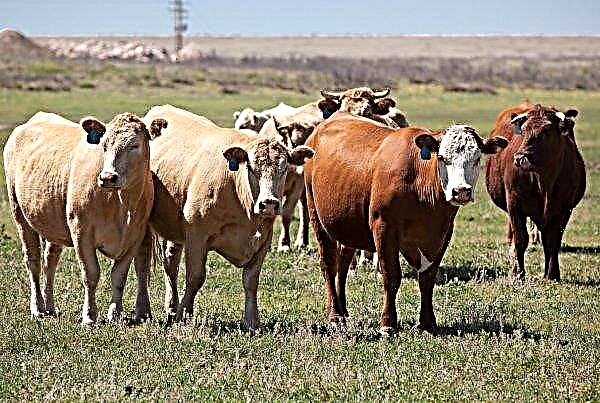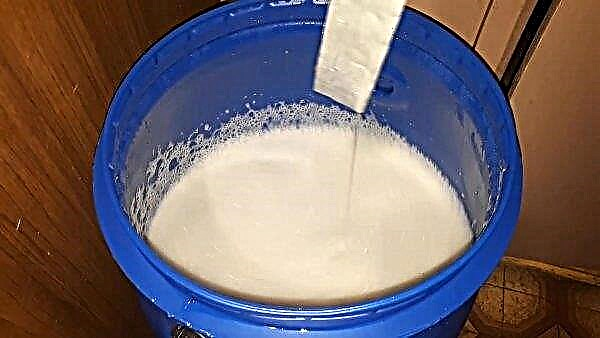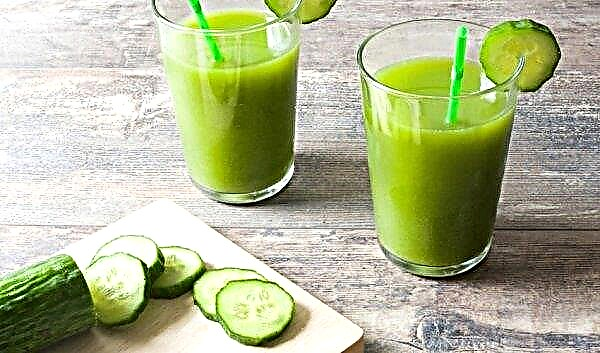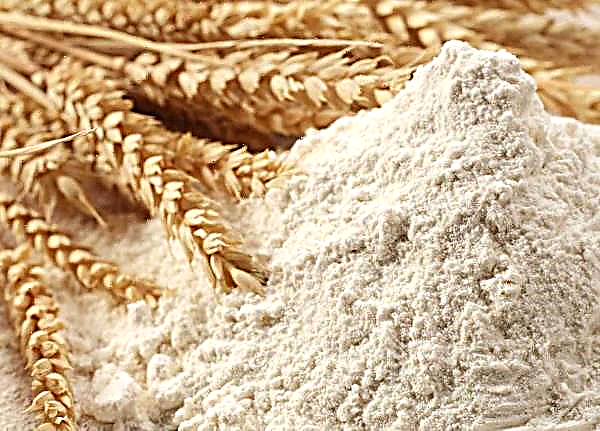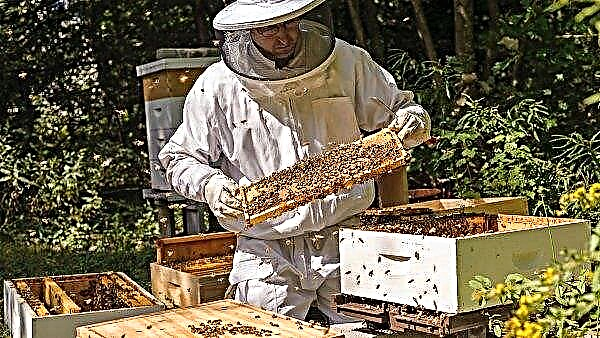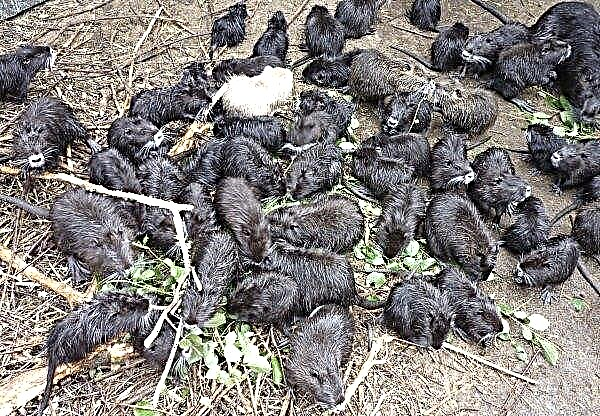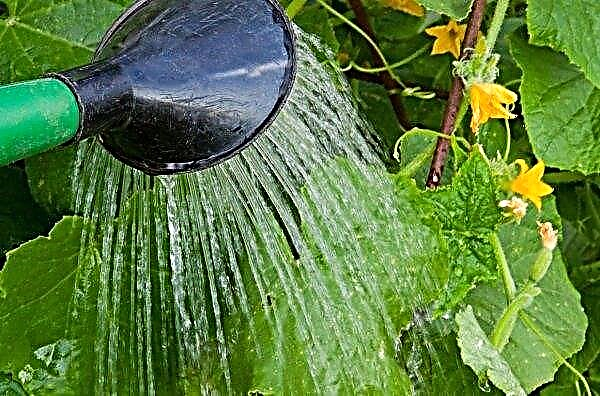Before acquiring a garden plant of a new variety, it is necessary to study all available information about the requirements for care and cultivation features. You will learn about what you need to grow a Felox potato variety from this article.
Breed cultivation
The Felox variety was produced in Germany by Saka Palanzenzucht. Today it is grown almost all over the world - in Europe, America, Asia, India, China, in the territory of the countries of the former Union. This is possible due to the fact that the culture adapts well to any climate, soil, tolerates colds, temperature jumps and dry periods. The variety is listed in the State Register of the Russian Federation with a recommendation for cultivation in the Middle Volga region.
Did you know? The largest tuber in the world weighing 11.2 kg was able to grow Lebanese farmer Khalil Semkhat. He hit the pages of the Guinness Book of Records.
Botanical Description
Consider the main external characteristics of the variety and fruits, as well as their advantages and disadvantages.
Potato Description
Tubers are formed elongated in shape. The mass of one instance is 100–120 g. When planting in favorable climatic conditions and when carrying out quality care, one tuber can gain 200 g. The peel is painted in amber color. The pulp of light tones. It is distinguished by high palatability. The tubers contain from 16 to 17% starch. Potato Felox can be used for any culinary purpose. When cutting, it does not darken. Tubers tolerate transportation well, keeping marketability at 98%. To date, the variety has become widespread throughout the world.
To date, the variety has become widespread throughout the world.
Bush description
The bush grows straight, with lots of leaves. The leaves are large, dark green, serrated at the edges. The top sheet plate is glossy. Flowering burgundy-lilac.
Ripening dates and productivity
Tubers ripen early. From the appearance of seedlings to harvesting fruit takes 60–70 days. On one bush, 19 to 25 tubers can be tied. Productivity of the variety is 550-600 kg / ha.
Did you know? Europeans learned about the existence of potatoes in the 16th century, but for a long time they considered it a decorative plant that should not be eaten because of the toxicity. It was declared edible as a vegetable only in 1772, after long and serious research by agronomist Andre Permantier.
Resistance to disease
Felox bushes well resist potato cancer, golden nematode, exhibit moderate resistance to late blight and are often susceptible to attack by wireworms.
Pros and cons of the variety
- Gardeners who have already dealt with the cultivation of the described variety, note such positive characteristics:
- early ripening;
- undemanding to the composition and quality of the soil;
- simplicity at landing and leaving;
- optimal starch levels in fruits;
- high productivity;
- excellent taste and marketability of tubers;
- good immunity;
- the ability of tubers to tolerate transport;
- long shelf life.
- Among the shortcomings are:
- the need for additional protective treatments against late blight, wireworm, scab.
The technology of growing varieties in open ground
The highest possible yields can be achieved from potatoes, which are planted in a suitable place for it, after the recommended predecessors, in the required time, with the correct preparation of the soil and planting material. This subspecies grows best in soft, loose soil. In stony land during the growing season, bushes can slow down significantly. In this case, the tubers are strongly deformed
This subspecies grows best in soft, loose soil. In stony land during the growing season, bushes can slow down significantly. In this case, the tubers are strongly deformed
Optimal landing location and timing
When growing on open beds for potatoes, a place should be allocated that is adequately lit by the sun. According to the rules of crop rotation, the seeds should be placed in the ground, where green manure, cucumbers, legumes, onions, cabbage, carrots, and beets used to grow. Planting on beds previously occupied by potatoes, tomatoes, peppers is not recommended. When planting, it is necessary to determine the temperature of the soil - at a depth of 10 cm, it should warm up to + 8 ... + 10 ° C.
Depending on the region of cultivation, this can be observed from late March to early May. When planting early, beds should be covered with a film or non-woven material. There is another way to determine the most successful time for planting potatoes - folk signs. According to experienced gardeners, a clear sign that the seeds should be buried in the ground is the blooming of buds on birches and flowers on bird cherry.
Soil type
The type of soil for Felox potatoes is suitable for anyone. Important conditions for successful potato cultivation are:
- occurrence of groundwater at a level no closer than 65–70 cm from the soil surface;
- neutral or slightly alkaline pH reaction.
Important! Reducing acidity contributes to the introduction of lime, dolomite flour, wood ash, crushed eggshells into the soil.
Successful growth and development of culture largely depends on how well prepared the site is for planting. Preparation is made in the fall or in the spring. In the autumn period, it is necessary to remove plant debris from it, make a deep digging (20–25 cm deep) and top dressing using urea, manure, wood ash. If fertilizer did not work out in the fall, then the beds are fertilized in the spring. For 2-3 weeks, you need to prepare the holes for planting and add to each of them 1 liter of dry humus, 1 handful of wood ash, 1 tbsp. l nitrofoski, 1 tbsp. ammofoski, 0.5 tbsp. dolomite flour. Another feeding option is also possible: 2-3 handfuls of humus (rotted compost), 1 tbsp. wood ash, a small amount of chicken droppings, 3-4 tbsp. onion peel. During this period, you can not make fresh manure. He is able to burn seeds.
For 2-3 weeks, you need to prepare the holes for planting and add to each of them 1 liter of dry humus, 1 handful of wood ash, 1 tbsp. l nitrofoski, 1 tbsp. ammofoski, 0.5 tbsp. dolomite flour. Another feeding option is also possible: 2-3 handfuls of humus (rotted compost), 1 tbsp. wood ash, a small amount of chicken droppings, 3-4 tbsp. onion peel. During this period, you can not make fresh manure. He is able to burn seeds.
Preparing planting material
Potato seeds must be sprouted before planting. To do this, in about a month they are moved from the place of storage to a room well-lit with diffused light with a temperature of + 13 ... + 16 ° С and humidity of 90–95%. Then produce culling, removing large and small tubers, damaged, diseased, without sprouts. For seeds suitable for planting, the sprouts should reach a length of 1 cm. 3 days before planting, the selected tubers should be placed in an aqueous solution of wood ash, Prestige or Epin-Extra preparations. Thanks to growth stimulants, the bushes grow more magnificent, and tubers also form quickly. This is necessary in order to prevent infection of plants with some diseases and the defeat of harmful insects. So that the seeds sprout faster, they are placed in “Kornevin” or “Heteroauxin”. Germination can be reduced to 20 days by placing seeds in moistened sawdust, peat, pre-treated with a solution of copper sulfate (2 g / 1 l of water). Seeds can also be placed in glass containers with a volume of 3 l, which are then put on a light and warm windowsill.
Thanks to growth stimulants, the bushes grow more magnificent, and tubers also form quickly. This is necessary in order to prevent infection of plants with some diseases and the defeat of harmful insects. So that the seeds sprout faster, they are placed in “Kornevin” or “Heteroauxin”. Germination can be reduced to 20 days by placing seeds in moistened sawdust, peat, pre-treated with a solution of copper sulfate (2 g / 1 l of water). Seeds can also be placed in glass containers with a volume of 3 l, which are then put on a light and warm windowsill.
Important! When planting Felox potatoes in regions where frost has been observed for a long time, overripe herbal plants are laid on the bottom of the holes. So you can protect the seeds from freezing.
Landing methods and scheme
They dig holes for landing with a distance of 35–40 cm from each other. The row spacing should be 70–80 cm. How to dig holes deeply depends on the type of soil. In light and loose soils, the recommended depth of the holes is 6–7 cm. If the earth is heavier, then the seeds should be deepened by 7–8 cm. In very heavy, clay soils, the holes should go 8–9 cm deep.
The technology of planting potatoes is as follows:
- Place 1-2 seeds in one hole.
- Fill the hole to the edges with soil.
- Loosen the beds.
- Cover the landings with foil (if required).
Video: planting potatoes
Further planting care
Potatoes do not require a lot of attention. However, a high-quality and rich harvest is possible only with regular care. Mandatory measures for the cultivation of this crop are watering, fertilizing, soil care, prevention against diseases and parasites.
Feeding and irrigation scheme
Potatoes, like other garden plants, need to be fed with nutrients. It is better to do this by adding organic compounds, for example, mullein, herbal tea, bird droppings, wood ash. If it’s difficult to get organics, then you can buy mineral fertilizers.
Important! Chemical treatments should be carried out in accordance with personal safety measures, protecting the airways with a respirator, eyes with special glasses, hands with gloves, and the body with protective clothing.
When drawing up a fertilizer application schedule, you can use the recommendations given in the table:
| Application Period | Fertilizer |
| At the beginning of the growing season | Ammonium nitrate or carbide (15–20 g / 10 l of water) |
| In the period of the appearance of the fruit | Superphosphate (35–40 g / 10 L water), potassium sulfate (25–30 g / 10 L water) with the addition of boric acid (3–5 g), potassium permanganate (1–2 g), copper sulfate (1–2 g) or zinc sulfate (1-2 g) |
How many times to water a potato will depend on climatic conditions and the soil in which it is planted. The minimum number of humidifications required for a season with sufficient rainfall is 3. If frequent and prolonged droughts are observed, it is recommended to water the beds every 4 days. Water consumption for one plant is 2.5–3 liters.
Video: feeding potatoes
Periods during which the potato must receive water:
- When plants reach a height of 8–10 cm (usually at the end of the first summer month).
- During the budding period (in mid-July).
- When tubers form (at the beginning of the last month of summer).
The best method of watering potatoes is sprinkling. It must be planned for the morning hours, since the aggressive sun can leave burns on the leaves if moisture drops do not have time to dry on them. Soil moisture should be combined with cultivation. For potatoes, it should be shallow - up to 3 cm. Potato bushes also require hilling. During the growth of the plant, it is recommended to perform 3 procedures that have a beneficial effect on the roots and protect the plantings from the cold. Hilling involves rolling mounds of earth around the stems.
For potatoes, it should be shallow - up to 3 cm. Potato bushes also require hilling. During the growth of the plant, it is recommended to perform 3 procedures that have a beneficial effect on the roots and protect the plantings from the cold. Hilling involves rolling mounds of earth around the stems.
Pest and Disease Control
The Felox variety has strong immunity and well resists the most dangerous diseases and harmful insects. Prevention should be carried out against late blight, scab and wireworm.
The main symptom of late blight infection is dark spots on foliage and stems. As it develops, the disease penetrates the fruits and causes them to rot. It is important to carry out preventive measures against this disease, namely: culling and disinfecting planting material, thorough autumn cleaning of the site, preventing thickening of beds, carrying out hilling, observing crop rotation rules, treating with serum, garlic infusion, iodine, and copper sulfate. In case of infection, treatment with Alirin-B and Gamair will be required. Scab it infects tubers, leading to the appearance of ulcers and spots on them, as a result of which their taste worsens, the length of the bed is reduced, and the level of starch decreases. The fight against the disease are drugs "Maxim", "Fitosporin", "Kuproksat", "Acrobat MC". In order to prevent an ailment in the garden, the tubers are disinfected before planting, observe crop rotation rules when choosing a plot for beds, and planting material is stored correctly.
Scab it infects tubers, leading to the appearance of ulcers and spots on them, as a result of which their taste worsens, the length of the bed is reduced, and the level of starch decreases. The fight against the disease are drugs "Maxim", "Fitosporin", "Kuproksat", "Acrobat MC". In order to prevent an ailment in the garden, the tubers are disinfected before planting, observe crop rotation rules when choosing a plot for beds, and planting material is stored correctly. The wireworm is called the larva of the nutcracker. It looks like a worm 1-3 cm long, has a rigid body of yellow color. This insect damages the root system. After its harmful activity, the roots begin to rot.
The wireworm is called the larva of the nutcracker. It looks like a worm 1-3 cm long, has a rigid body of yellow color. This insect damages the root system. After its harmful activity, the roots begin to rot. Reproduction of wireworms contributes to the contamination of the site, the lack of quality land care. It is important to timely weed, loosen, dig, add lime, wood ash to the soil, and feed the site with nitrogen fertilizers (for example, ammonium sulfate - 25 g / 1 m²). It will also be effective to install special traps that catch nutcracker beetles. Treatment with Topaz, Strobi, and Prestige will help save plants during infection.
Reproduction of wireworms contributes to the contamination of the site, the lack of quality land care. It is important to timely weed, loosen, dig, add lime, wood ash to the soil, and feed the site with nitrogen fertilizers (for example, ammonium sulfate - 25 g / 1 m²). It will also be effective to install special traps that catch nutcracker beetles. Treatment with Topaz, Strobi, and Prestige will help save plants during infection. Before planting, it is worth treating potato tubers with a potassium permanganate solution.
Before planting, it is worth treating potato tubers with a potassium permanganate solution.
Mulching and weed control
It is recommended to cover the beds with potatoes with mulch - a 5–7-cm layer of grass, straw, peat crumbs. These materials will not allow weeds to grow actively and will maintain soil moisture at the right level. As necessary, it is worth removing weeds from the site that take light, nutrients from potato bushes and become a source of infection for most diseases and harmful insects.
Harvesting and storage
The readiness of the fruits for harvesting is determined by the condition of the lower leaves. If they turn yellow, then you can make the first digging. Full harvesting is necessary when the tops turn yellow to the top. If we talk about calendar dates, then, as a rule, the fruits of Felox ripen in late August. Tubers are dug up with a shovel or pitchfork, and then cleaned from the ground. The first 7-14 days after harvesting, the potatoes are stored in bags in a room with no sunlight and good ventilation.
Optimum storage temperature - + 15 ... + 20 ° С. After this, the tubers unsuitable for lying are removed - diseased, damaged, rotten, with spots. The best specimens are placed in a storage with a temperature of + 3 ... + 5 ° С, humidity at the level of 90–95% and good air circulation. With proper storage, tubers of this variety can be stored for up to 6 months. Summing up the foregoing, we note that the Felox variety is classified as medium early and high yielding. It has a number of advantages, which include a good adaptation to external conditions, tasty fruits, unpretentiousness in care. All this gives reason to recommend it for growing in the garden.
Summing up the foregoing, we note that the Felox variety is classified as medium early and high yielding. It has a number of advantages, which include a good adaptation to external conditions, tasty fruits, unpretentiousness in care. All this gives reason to recommend it for growing in the garden.

